Characterization of Growth Secondary Hair in Min Pig Activated by Follicle Stem Cell Stimulated by Wnt and BMP Signaling Pathway
Abstract
Simple Summary
Abstract
1. Introduction
2. Materials and Methods
2.1. Animals and Sample Preparation
2.2. Histological Study of Hair Follicle and Skin with H&E Staining
2.3. RNA Extraction
2.4. RNA-Seq Experiments
2.5. Analysis of RNA-Seq Datasets
2.6. Differential Expression Analysis
2.7. Quantitative Reverse Transcription-Polymerase Chain Reaction
2.8. Wnt and BMP for Hair Growth in Min Pig
2.9. Immunofluorescence
2.10. Statistical Analysis
3. Results
3.1. Observation of the Hair of the Three Pig Breeds
3.2. Histological Analysis of Skin and Follicle Morphology
3.3. Differentially Expressed Genes
3.4. Quantitative Real-Time RT-PCR for the Gene Expression
3.5. Density of the Follicles under the Wnt and BMP Pathways
3.6. Wnt and BMP Signaling Molecules Stimulate the Hair Follicle Stem Cell Differentiation
3.7. Quantitative Real-Time RT-PCR Analysis Results
4. Discussion
5. Conclusions
Author Contributions
Funding
Institutional Review Board Statement
Informed Consent Statement
Data Availability Statement
Acknowledgments
Conflicts of Interest
References
- Larson, G.; Dobney, K.; Albarella, U.; Fang, M.; Matisoo-Smith, E.; Robins, J.; Lowden, S.; Finlayson, H.; Brand, T.; Willerslev, E.; et al. Worldwide phylogeography of wild boar reveals multiple centers of pig domestication. Science 2005, 307, 1618–1621. [Google Scholar] [CrossRef] [PubMed]
- Leite, J.; Da Silva, R.G.; da Silva, W.S.T.; da Silva, W.E.; Paiva, R.D.M.; Sousa, J.E.R.; Asensio, L.A.B.; Facanha, D.A.E. Locally adapted Brazilian ewes with different coat colors maintain homeothermy during the year in an equatorial semiarid environment. Int. J. Biometeorol. 2018, 62, 1635–1644. [Google Scholar] [CrossRef] [PubMed]
- Schachler, K.; Distl, O.; Metzger, J. Tracing selection signatures in the pig genome gives evidence for selective pressures on a unique curly hair phenotype in Mangalitza. Sci. Rep. 2020, 10, 22142. [Google Scholar] [CrossRef]
- Yang, X.Q.; Liu, H.; Guo, L.J.; Xu, Y.; Liu, D. The mutation site analysis on CAPN1 gene of wild boar, min pig and Yorkshire. Yi Chuan 2007, 29, 581–586. [Google Scholar] [CrossRef] [PubMed]
- Liu, Y.; Yang, X.; Jing, X.; He, X.; Wang, L.; Liu, Y.; Liu, D. Transcriptomics analysis on excellent meat quality traits of skeletal muscles of the Chinese indigenous min pig compared with the large white breed. Int. J. Mol. Sci. 2017, 19. [Google Scholar] [CrossRef]
- Committee, C.A.G.R. Animal Genetic Resources in China, 1st ed.; China Agriculture Press: Beijing, China, 2011; Volume 7, p. 26. [Google Scholar]
- Watson, S.A.; Moore, G.P. Postnatal development of the hair cycle in the domestic pig. J. Anat. 1990, 170, 1–9. [Google Scholar]
- Liu, G.; Liu, R.; Li, Q.; Tang, X.; Yu, M.; Li, X.; Cao, J.; Zhao, S. Identification of microRNAs in wool follicles during anagen, catagen, and telogen phases in tibetan sheep. PLoS ONE 2013, 8, e77801. [Google Scholar] [CrossRef]
- Tian, M.; He, X.; Wang, W.; Feng, Y.; Zhang, D.; Li, Z.; Liu, D. Transcriptome analysis reveals genes contributed to min pig villi hair follicle in different seasons. Vet. Sci. 2022, 9, 639. [Google Scholar] [CrossRef]
- Leite, J.; Da Silva, R.G.; Asensio, L.A.B.; de Sousa, J.E.R.; da Silva, W.S.T.; da Silva, W.E.; Facanha, D.A.E. Coat color and morphological hair traits influence on the mechanisms related to the heat tolerance in hair sheep. Int. J. Biometeorol. 2020, 64, 2185–2194. [Google Scholar] [CrossRef]
- Chen, J.; Ni, P.; Thi, T.N.T.; Kamaldinov, E.V.; Petukhov, V.L.; Han, J.; Liu, X.; Sprem, N.; Zhao, S. Selective constraints in cold-region wild boars may defuse the effects of small effective population size on molecular evolution of mitogenomes. Ecol. Evol. 2018, 8, 8102–8114. [Google Scholar] [CrossRef]
- Jablonski, N.G.; Chaplin, G. The evolution of skin pigmentation and hair texture in people of African ancestry. Dermatol. Clin. 2014, 32, 113–121. [Google Scholar] [CrossRef] [PubMed]
- Brettmann, E.A.; de Guzman Strong, C. Recent evolution of the human skin barrier. Exp. Dermatol. 2018, 27, 859–866. [Google Scholar] [CrossRef] [PubMed]
- Chen, C.L.; Huang, W.Y.; Wang, E.H.C.; Tai, K.Y.; Lin, S.J. Functional complexity of hair follicle stem cell niche and therapeutic targeting of niche dysfunction for hair regeneration. J. Biomed. Sci. 2020, 27, 43. [Google Scholar] [CrossRef] [PubMed]
- Meyer, W.; Gorgen, S.; Schlesinger, C. Structural and histochemical aspects of epidermis development of fetal porcine skin. Am. J. Anat. 1986, 176, 207–219. [Google Scholar] [CrossRef]
- Naboulsi, R.; Cieslak, J.; Headon, D.; Jouni, A.; Negro, J.J.; Andersson, G.; Lindgren, G. The enrichment of specific hair follicle-associated cell populations in plucked hairs offers an opportunity to study gene expression underlying hair traits. Int. J. Mol. Sci. 2022, 24, 561. [Google Scholar] [CrossRef]
- Ding, H.; Zhao, H.; Cheng, G.; Yang, Y.; Wang, X.; Zhao, X.; Qi, Y.; Huang, D. Analyses of histological and transcriptome differences in the skin of short-hair and long-hair rabbits. BMC Genom. 2019, 20, 140. [Google Scholar] [CrossRef]
- Meyer, W.; Gorgen, S. Development of hair coat and skin glands in fetal porcine integument. J. Anat. 1986, 144, 201–220. [Google Scholar] [PubMed]
- Jiang, X.; Xia, S.; He, X.; Ma, H.; Feng, Y.; Liu, Z.; Wang, W.; Tian, M.; Chen, H.; Peng, F.; et al. Targeting peptide-enhanced antibody and CD11c(+) dendritic cells to inclusion bodies expressing protective antigen against ETEC in mice. FASEB J. 2019, 33, 2836–2847. [Google Scholar] [CrossRef]
- Song, S.Q.; Ma, W.W.; Zeng, S.X.; Zhang, C.L.; Yan, J.; Sun, C.C.; Li, X.; Wang, R.M.; Li, Z.Q. Transcriptome analysis of differential gene expression in the longissimus dorsi muscle from Debao and landrace pigs based on RNA-sequencing. Biosci. Rep. 2019, 39, BSR20192144. [Google Scholar] [CrossRef]
- Xi, Y.; Fowdur, M.; Liu, Y.; Wu, H.; He, M.; Zhao, J. Differential expression and bioinformatics analysis of circRNA in osteosarcoma. Biosci. Rep. 2019, 39, BSR20181514. [Google Scholar] [CrossRef]
- Trapnell, C.; Roberts, A.; Goff, L.; Pertea, G.; Kim, D.; Kelley, D.R.; Pimentel, H.; Salzberg, S.L.; Rinn, J.L.; Pachter, L. Differential gene and transcript expression analysis of RNA-seq experiments with TopHat and Cufflinks. Nat. Protoc. 2012, 7, 562–578. [Google Scholar] [CrossRef]
- Zhan, H.; Xiong, Y.; Wang, Z.; Dong, W.; Zhou, Q.; Xie, S.; Li, X.; Zhao, S.; Ma, Y. Integrative analysis of transcriptomic and metabolomic profiles reveal the complex molecular regulatory network of meat quality in Enshi black pigs. Meat. Sci. 2022, 183, 108642. [Google Scholar] [CrossRef] [PubMed]
- Liu, Z.; Chen, J.; Hu, L.; Li, M.; Liang, M.; Chen, J.; Lin, H.; Zeng, Z.; Yin, W.; Dong, Z.; et al. Expression profiles of genes associated with inflammatory responses and oxidative stress in lung after heat stroke. Biosci. Rep. 2020, 40. [Google Scholar] [CrossRef] [PubMed]
- Li, B.; Dewey, C.N. RSEM: Accurate transcript quantification from RNA-Seq data with or without a reference genome. BMC Bioinform. 2011, 12, 323. [Google Scholar] [CrossRef] [PubMed]
- Song, J.; Wang, W.; Yuan, Y.; Ban, Y.; Su, J.; Yuan, D.; Chen, W.; Zhu, J. Identification of immune-based prostate cancer subtypes using mRNA expression. Biosci. Rep. 2021, 41, BSR20201533. [Google Scholar] [CrossRef]
- Zhao, S.; Guo, Y.; Sheng, Q.; Shyr, Y. Advanced heat map and clustering analysis using heatmap3. Biomed. Res. Int. 2014, 2014, 986048. [Google Scholar] [CrossRef] [PubMed]
- Love, M.I.; Huber, W.; Anders, S. Moderated estimation of fold change and dispersion for RNA-seq data with DESeq2. Genome Biol. 2014, 15, 550. [Google Scholar] [CrossRef]
- Ferreira, J.A. The benjamini-hochberg method in the case of discrete test statistics. Int. J. Biostat. 2007, 3, 11. [Google Scholar] [CrossRef] [PubMed]
- Jiang, X.; Gu, S.; Liu, D.; Zhao, L.; Xia, S.; He, X.; Chen, H.; Ge, J. Lactobacillus brevis 23017 relieves mercury toxicity in the colon by modulation of oxidative stress and inflammation through the interplay of MAPK and NF-kappaB signaling cascades. Front. Microbiol. 2018, 9, 2425. [Google Scholar] [CrossRef]
- Hong, L.; Han, K.; Wu, K.; Liu, R.; Huang, J.; Lunney, J.K.; Zhao, S.; Yu, M. E-cadherin and ZEB2 modulate trophoblast cell differentiation during placental development in pigs. Reproduction 2017, 154, 765–775. [Google Scholar] [CrossRef]
- Zhang, G.F.; Qiu, L.; Yang, S.L.; Wu, J.C.; Liu, T.J. Wnt/beta-catenin signaling as an emerging potential key pharmacological target in cholangiocarcinoma. Biosci. Rep. 2020, 40, BSR20193353. [Google Scholar] [CrossRef]
- Mohedas, A.H.; Xing, X.; Armstrong, K.A.; Bullock, A.N.; Cuny, G.D.; Yu, P.B. Development of an ALK2-biased BMP type I receptor kinase inhibitor. ACS Chem. Biol. 2013, 8, 1291–1302. [Google Scholar] [CrossRef] [PubMed]
- Dey, D.; Bagarova, J.; Hatsell, S.J.; Armstrong, K.A.; Huang, L.; Ermann, J.; Vonner, A.J.; Shen, Y.; Mohedas, A.H.; Lee, A.; et al. Two tissue-resident progenitor lineages drive distinct phenotypes of heterotopic ossification. Sci. Transl. Med. 2016, 8, 366ra163. [Google Scholar] [CrossRef] [PubMed]
- Zeng, Y.B.; Yu, Z.C.; He, Y.N.; Zhang, T.; Du, L.B.; Dong, Y.M.; Chen, H.W.; Zhang, Y.Y.; Wang, W.Q. Salinomycin-loaded lipid-polymer nanoparticles with anti-CD20 aptamers selectively suppress human CD20+ melanoma stem cells. Acta Pharmacol. Sin. 2018, 39, 261–274. [Google Scholar] [CrossRef]
- Wu, Z.; Zhu, Y.; Liu, H.; Liu, G.; Li, F. Wnt10b promotes hair follicles growth and dermal papilla cells proliferation via Wnt/beta-Catenin signaling pathway in Rex rabbits. Biosci. Rep. 2020, 40, BSR20191248. [Google Scholar] [CrossRef]
- Meyer, W.; Zschemisch, N.H.; Godynicki, S.; Neurand, K. The structure of the skin of the ear in domesticated pigs, with special reference to their use for human dermatological research. 2. Specific histology of the integument. Berl. Munch. Tierarztl. Wochenschr. 2001, 114, 100–111. [Google Scholar]
- Kim, K.I.; Lee, J.H.; Li, K.; Zhang, Y.P.; Lee, S.S.; Gongora, J.; Moran, C. Phylogenetic relationships of Asian and European pig breeds determined by mitochondrial DNA D-loop sequence polymorphism. Anim. Genet. 2002, 33, 19–25. [Google Scholar] [CrossRef] [PubMed]
- Nakajima, E.; Itoh, T.; Suzuki, K.; Kawakami, K.; Takeda, K.; Onishi, A.; Komatsu, M. Characterization, chromosomal localization, and genetic variation of the alpha subunit of porcine eighth component of complement. Anim. Genet. 1998, 29, 377–380. [Google Scholar] [CrossRef]
- Zhang, Y.; Wu, K.; Wang, L.; Wang, Z.; Han, W.; Chen, D.; Wei, Y.; Su, R.; Wang, R.; Liu, Z.; et al. Comparative study on seasonal hair follicle cycling by analysis of the transcriptomes from cashmere and milk goats. Genomics 2020, 112, 332–345. [Google Scholar] [CrossRef]
- Sikkink, S.K.; Mine, S.; Freis, O.; Danoux, L.; Tobin, D.J. Stress-sensing in the human greying hair follicle: Ataxia Telangiectasia Mutated (ATM) depletion in hair bulb melanocytes in canities-prone scalp. Sci. Rep. 2020, 10, 18711. [Google Scholar] [CrossRef] [PubMed]
- Wiechers, D.H.; Brunner, S.; Herbrandt, S.; Kemper, N.; Fels, M. Analysis of hair cortisol as an indicator of Chronic Stress in pigs in two different farrowing systems. Front. Vet. Sci. 2021, 8, 605078. [Google Scholar] [CrossRef]
- Ahlawat, S.; Arora, R.; Sharma, R.; Sharma, U.; Kaur, M.; Kumar, A.; Singh, K.V.; Singh, M.K.; Vijh, R.K. Skin transcriptome profiling of Changthangi goats highlights the relevance of genes involved in Pashmina production. Sci. Rep. 2020, 10, 6050. [Google Scholar] [CrossRef]
- Liu, Z.; Yang, F.; Zhao, M.; Ma, L.; Li, H.; Xie, Y.; Nai, R.; Che, T.; Su, R.; Zhang, Y.; et al. The intragenic mRNA-microRNA regulatory network during telogen-anagen hair follicle transition in the cashmere goat. Sci. Rep. 2018, 8, 14227. [Google Scholar] [CrossRef]
- Bao, P.; Luo, J.; Liu, Y.; Chu, M.; Ren, Q.; Guo, X.; Tang, B.; Ding, X.; Qiu, Q.; Pan, H.; et al. The seasonal development dynamics of the yak hair cycle transcriptome. BMC Genom. 2020, 21, 355. [Google Scholar] [CrossRef]
- Rishikaysh, P.; Dev, K.; Diaz, D.; Qureshi, W.M.; Filip, S.; Mokry, J. Signaling involved in hair follicle morphogenesis and development. Int. J. Mol. Sci. 2014, 15, 1647–1670. [Google Scholar] [CrossRef]
- Jiang, L.; Xu, J.; Jin, R.; Bai, H.; Zhang, M.; Yang, S.; Zhang, X.; Zhang, X.; Han, Z.; Zeng, S. Transcriptomic analysis of chicken cochleae after gentamicin damage and the involvement of four signaling pathways (Notch, FGF, Wnt and BMP) in hair cell regeneration. Hear. Res. 2018, 361, 66–79. [Google Scholar] [CrossRef]
- Ramekers, D.; Klis, S.F.L.; Versnel, H. Simultaneous rather than retrograde spiral ganglion cell degeneration following ototoxically induced hair cell loss in the guinea pig cochlea. Hear. Res. 2020, 390, 107928. [Google Scholar] [CrossRef]
- Rompolas, P.; Deschene, E.R.; Zito, G.; Gonzalez, D.G.; Saotome, I.; Haberman, A.M.; Greco, V. Live imaging of stem cell and progeny behaviour in physiological hair-follicle regeneration. Nature 2012, 487, 496–499. [Google Scholar] [CrossRef]
- Villani, R.M.; Johnson, A.; Galbraith, J.A.; Baz, B.; Handoko, H.Y.; Walker, G.J.; Khosrotehrani, K. Murine dorsal hair type is genetically determined by polymorphisms in candidate genes that influence BMP and WNT signalling. Exp. Dermatol. 2020, 29, 450–461. [Google Scholar] [CrossRef]
- Infarinato, N.R.; Stewart, K.S.; Yang, Y.; Gomez, N.C.; Pasolli, H.A.; Hidalgo, L.; Polak, L.; Carroll, T.S.; Fuchs, E. BMP signaling: At the gate between activated melanocyte stem cells and differentiation. Genes Dev. 2020, 34, 1713–1734. [Google Scholar] [CrossRef]
- Ge, M.; Liu, C.; Li, L.; Lan, M.; Yu, Y.; Gu, L.; Su, Y.; Zhang, K.; Zhang, Y.; Wang, T.; et al. miR-29a/b1 inhibits hair follicle stem cell lineage progression by spatiotemporally suppressing WNT and BMP signaling. Cell Rep. 2019, 29, 2489.e2484–2504.e2484. [Google Scholar] [CrossRef] [PubMed]
- Cai, B.; Zheng, Y.; Yan, J.; Wang, J.; Liu, X.; Yin, G. BMP2-mediated PTEN enhancement promotes differentiation of hair follicle stem cells by inducing autophagy. Exp. Cell Res. 2019, 385, 111647. [Google Scholar] [CrossRef] [PubMed]
- Zhou, L.; Yang, K.; Carpenter, A.; Lang, R.A.; Andl, T.; Zhang, Y. CD133-positive dermal papilla-derived Wnt ligands regulate postnatal hair growth. Biochem. J. 2016, 473, 3291–3305. [Google Scholar] [CrossRef] [PubMed]
- Jaks, V.; Barker, N.; Kasper, M.; van Es, J.H.; Snippert, H.J.; Clevers, H.; Toftgard, R. Lgr5 marks cycling, yet long-lived, hair follicle stem cells. Nat. Genet. 2008, 40, 1291–1299. [Google Scholar] [CrossRef]
- Lin, J.; Zhang, X.; Wu, F.; Lin, W. Hair cell damage recruited Lgr5-expressing cells are hair cell progenitors in neonatal mouse utricle. Front. Cell Neurosci. 2015, 9, 113. [Google Scholar] [CrossRef]
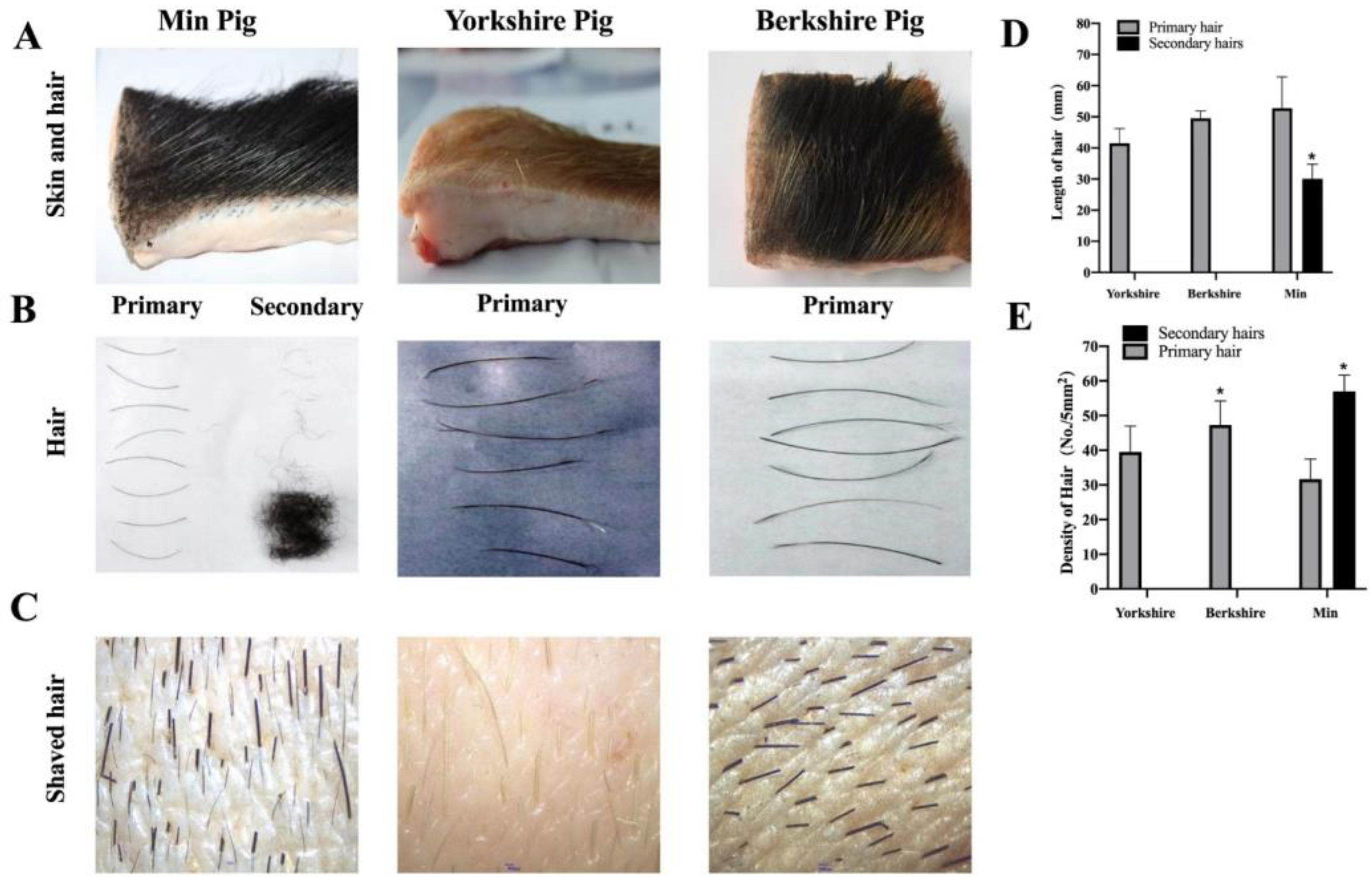

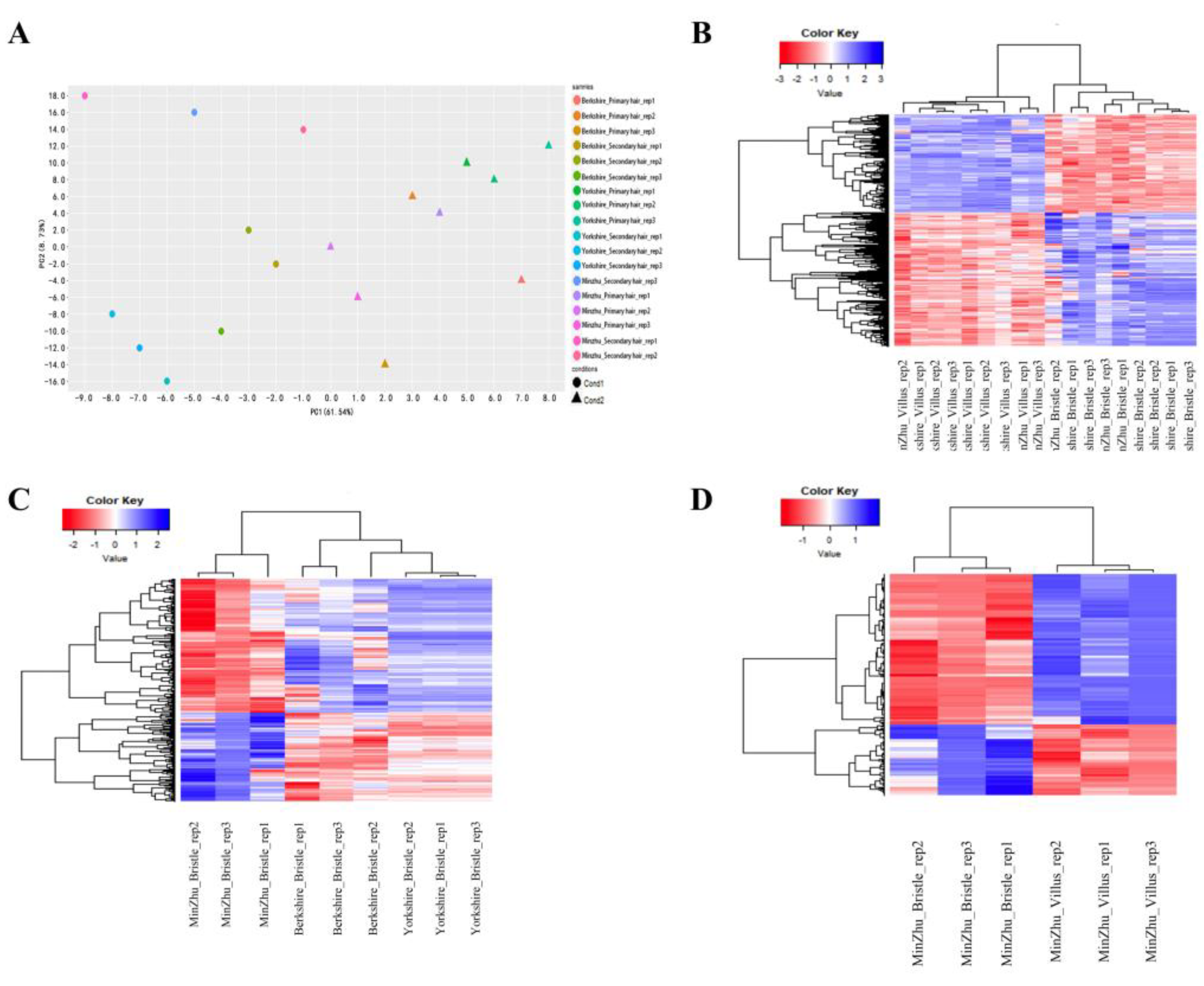
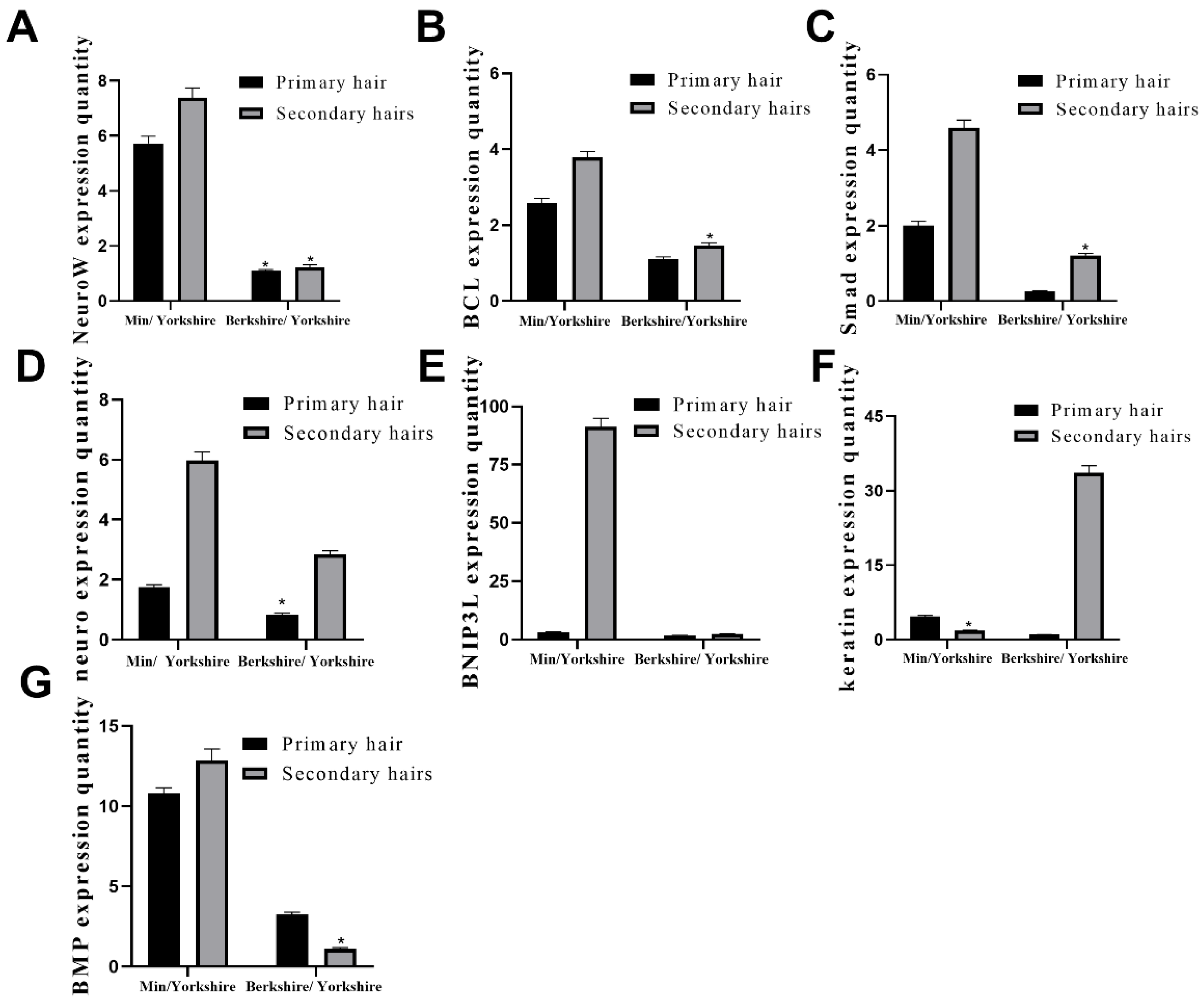

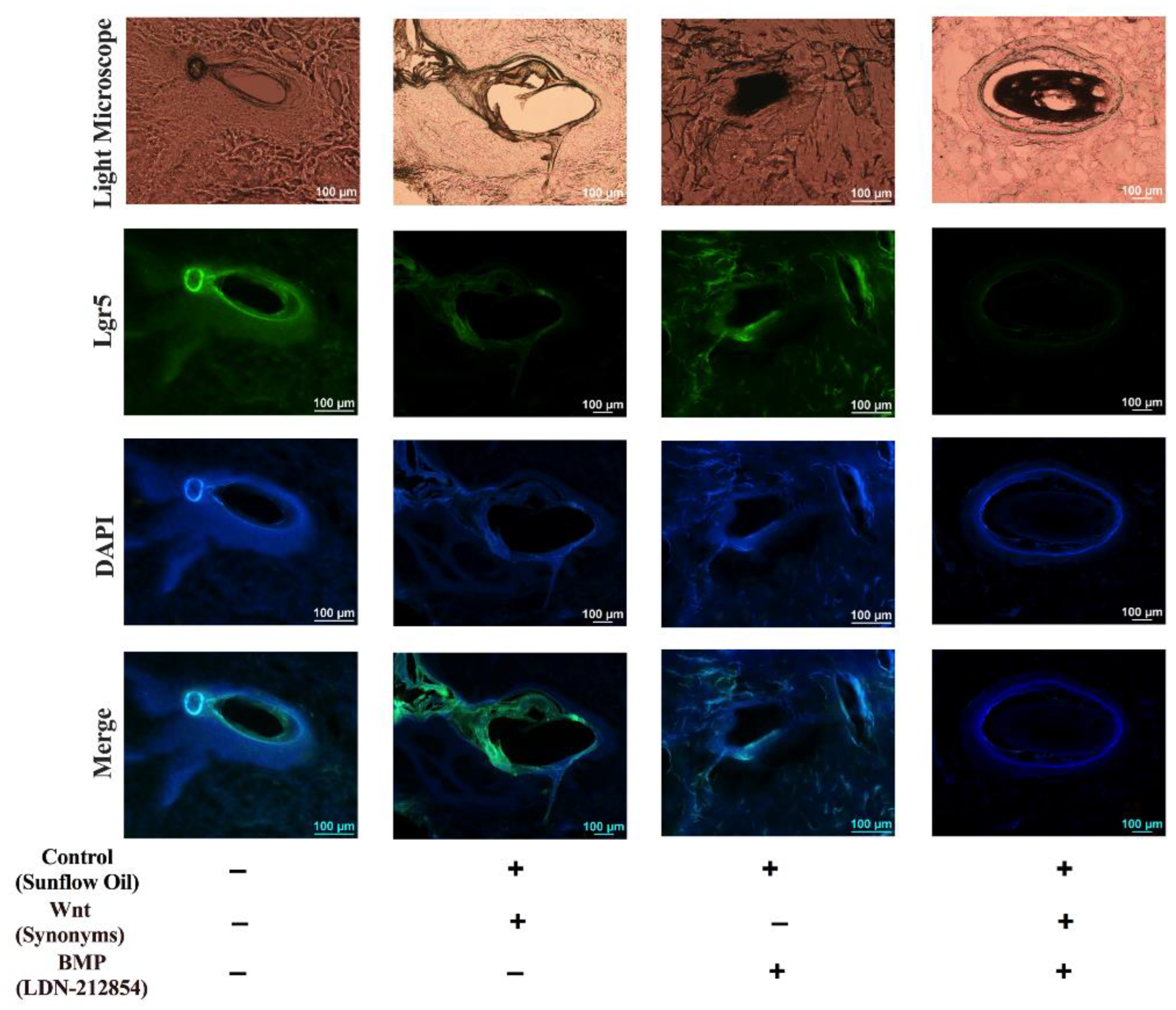
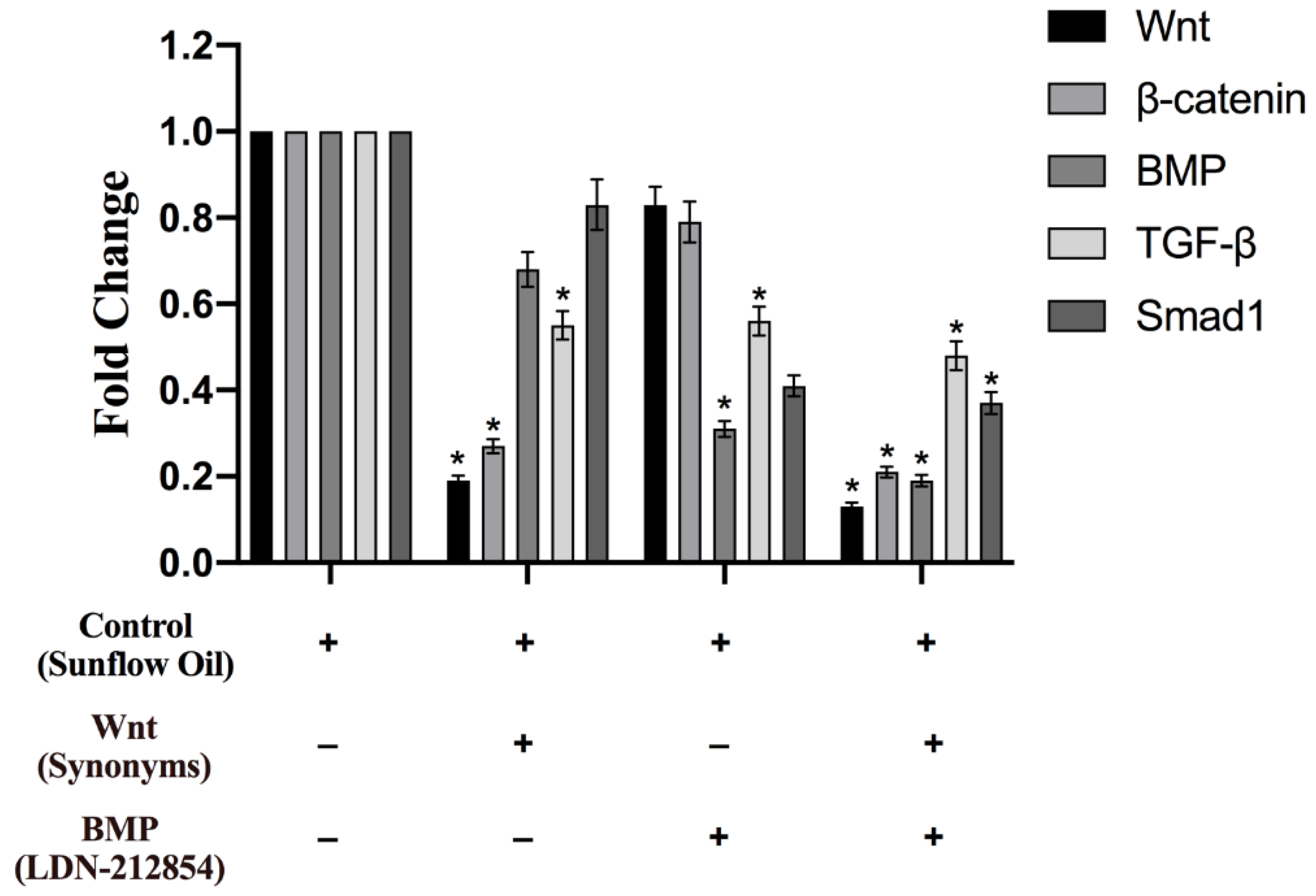
| Gene | NCBI Accession | Sequence (5′-3′) |
|---|---|---|
| BCL2 | XM_001927592.3 | F: ATGTTCAGGTCCAAACGCTCGG R: CTGCCCTTGCTCCCATCCTC |
| SMAD6 | XM_003480446.3 | F: GCGGCGACTTTGGCGAAGT R: GCGTCCCGGGGCCGCCGCAG |
| Neuropeptide W | NM_213786.1 | F: CCTCCGGAGCCAGTTCCTGG R: AGTAACAGCAATGCCAGCAGCC |
| keratin | XM_003126159.4 | F: CTCACCTATAGCACCACCCC R: GAGAGCAGCGAAGGGTCTTT |
| BMP | NM_001201485.1 | F: CCCAAATTCCCCTCTCACCC R: GCTACCGTCAGGCTGATACC |
| neuro | NM_001123152.1 | F: ATGTCCATCTTGTTTTATAT R: CTGGTAATTTTCCTGAAGGTCC |
Disclaimer/Publisher’s Note: The statements, opinions and data contained in all publications are solely those of the individual author(s) and contributor(s) and not of MDPI and/or the editor(s). MDPI and/or the editor(s) disclaim responsibility for any injury to people or property resulting from any ideas, methods, instructions or products referred to in the content. |
© 2023 by the authors. Licensee MDPI, Basel, Switzerland. This article is an open access article distributed under the terms and conditions of the Creative Commons Attribution (CC BY) license (https://creativecommons.org/licenses/by/4.0/).
Share and Cite
He, X.; Qin, Z.; Teng, R.; Tian, M.; Wang, W.; Feng, Y.; Chen, H.; He, H.; Zhang, H.; Liu, D.; et al. Characterization of Growth Secondary Hair in Min Pig Activated by Follicle Stem Cell Stimulated by Wnt and BMP Signaling Pathway. Animals 2023, 13, 1239. https://doi.org/10.3390/ani13071239
He X, Qin Z, Teng R, Tian M, Wang W, Feng Y, Chen H, He H, Zhang H, Liu D, et al. Characterization of Growth Secondary Hair in Min Pig Activated by Follicle Stem Cell Stimulated by Wnt and BMP Signaling Pathway. Animals. 2023; 13(7):1239. https://doi.org/10.3390/ani13071239
Chicago/Turabian StyleHe, Xinmiao, Ziliang Qin, Ran Teng, Ming Tian, Wentao Wang, Yanzhong Feng, Heshu Chen, Haijuan He, Haifeng Zhang, Di Liu, and et al. 2023. "Characterization of Growth Secondary Hair in Min Pig Activated by Follicle Stem Cell Stimulated by Wnt and BMP Signaling Pathway" Animals 13, no. 7: 1239. https://doi.org/10.3390/ani13071239
APA StyleHe, X., Qin, Z., Teng, R., Tian, M., Wang, W., Feng, Y., Chen, H., He, H., Zhang, H., Liu, D., & Jiang, X. (2023). Characterization of Growth Secondary Hair in Min Pig Activated by Follicle Stem Cell Stimulated by Wnt and BMP Signaling Pathway. Animals, 13(7), 1239. https://doi.org/10.3390/ani13071239





